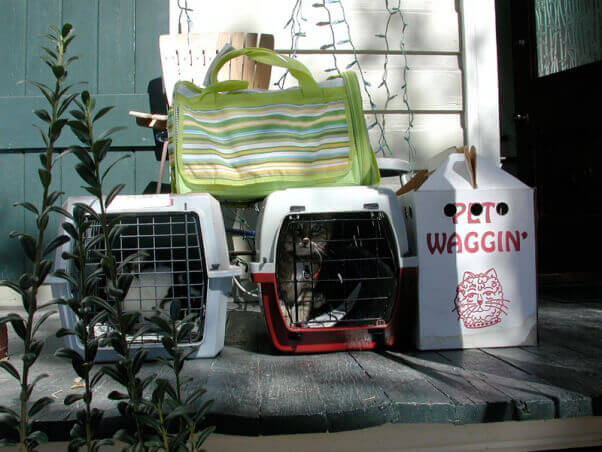What You NEED to Know About Wildfire Safety
Do you know how to keep your animal companions safe in case of a wildfire? Being prepared is your job as their guardian. PETA breaks down what you need to know to help keep animal companions safe in case of a wildfire evacuation.

Here’s a list of items to include in your companion animal wildfire evacuation kit as well as other important information:
Escape Routes and Destinations
- Before a disaster strikes, ensure that your planned destination accepts companion animals. (Evacuation shelters often don’t, but hotels and motels often do. Locations that usually don’t accept companion animals may allow them in an emergency.)
- Use a map to plan your escape route ahead of time. Have a Plan A, a Plan B, and maybe even a Plan C—you never know what roads may be closed during an emergency.
Identification, Documents, and Medication
- Animal companions should be microchipped. Keep the microchip registry up to date with your current e-mail address, home address, and phone number.
- Dogs and cats should wear properly fitted buckle collars with up-to-date ID tags that include a phone number. Dogs should also have a current license and rabies tag.
- Animals who can’t wear a collar (e.g., guinea pigs, fish, etc.) should have carriers labeled with their name and species and contact information for their guardians.
- Carry current photos of your animal companions in your wallet.
- Make sure you have photocopies or digital copies of adoption, veterinary, and vaccination records.
- Keep a list of medications as well as instructions for when and how to administer them to your animal companions.
Basic Care Necessities
- Enough food and water for one to two weeks
- Collapsible food and water bowls
- A can opener for canned food
- For dogs, a harness, a leash, and waste bags
- For cats, cat litter, a small litterbox, and waste bags
- A familiar blanket or bed and toys
- A towel and basic cleaning supplies (e.g., disinfectant, plastic bags, and paper towels)
- A companion animal first aid kit (e.g., antibiotic ointment, gauze, nonstick bandages, saline solution, disposable gloves, and styptic powder)
- Phone numbers for your primary veterinarian, your emergency veterinarian, and local animal shelters
- Medications, including heartworm preventive
Transport: Ensure All Animals Are Restrained While Moving
- Each small- to medium-size animal should have their own carrier for travel. Smaller animals who would take comfort in each other’s company can be kept together in an adequately sized carrier. A towel or sheet placed over the top of the carrier can help keep animals calm.
- Dogs who are too big for a carrier or who are uncomfortable in one should be secured in a crash-tested harness, booster seat, or seat belt.
- Keep travel supplies (e.g., a leash, harness, carriers, etc.) near the door at all times.
- Never leave animals unsupervised in a motor vehicle.

What to Do for Reptiles, Fish, and Other Small Animals
- For fish, lidded containers with small air holes should be ready to hold them with water from their aquarium. A 5-gallon bucket with a hole for their air pump is ideal. A lid will secure fish in a car and help prevent splashing.
- For reptiles, be sure to have heat lamps and pads easily accessible in case of a wildfire evacuation.
- Don’t feed reptiles until you’ve arrived at your predetermined destination and set up a proper heating source. Reptiles won’t be able to digest their food properly unless they’re at a safe temperature specific to their species.
- Have a few gallons of water ready. Water sources can become dirty or contaminated during an emergency and could cause serious problems for fish, reptiles, or other small animals.
How to Help Large Animals in Case of a Wildfire
- Local fairgrounds and other sites may have the capacity to care for large animals in an emergency. Before a warning is in place, contact these facilities and have a plan ready.
- Horses, sheep, cows, llamas, and other large animals should never be locked in stalls or otherwise confined. If you’re able to bring these animals with you in a trailer, do so.
- If it’s impossible to transport the animals, they should be freed so that they can flee the flames and attempt to survive.
What You Can Do to Help Limit Wildfires and the Climate Catastrophe
From the 75-day increase in the average wildfire season in California to the roughly 9.4 million acres burned in the 2023 wildfires in Canada, it’s clear that wildfires are worsening. Due to rising temperatures caused by the climate catastrophe, trees, grasses, and soil that were previously lush are dry during hotter months. These dry conditions create the perfect environment for wildfires to start and spread quickly.

The exploitation of animals for food is responsible for nearly one-fifth of all human-caused greenhouse gas emissions. Do your part to help stop the climate catastrophe and the wildfires that come with it: Go vegan today.




